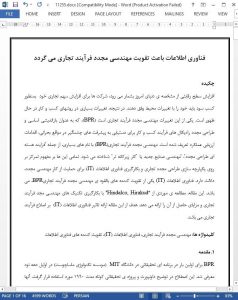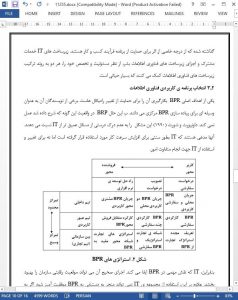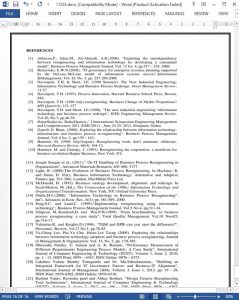ABSTRACT
Today's environment is characterized by increasing levels of competition. Enterprises wanting to increase their market share or obtain profits must adapt to changes in the environment. Consequently, many changes in business methods are beginning to appear. One of them is business process reengineering (BPR), defined as the fundamental rethinking and radical redesign of business processes to achieve dramatic improvementsin critical, contemporary measures of performance. Business Process Reengineering (BPR) is known by many names, such as ‘core process redesign’, ‘new industrial engineering’ or ‘working smarter’. All of themimply the same concept that focuses on integrating both business process redesign and deployment of information technologies (IT) to support the reengineering work. Among the potential enablers of BPR is information technology (IT). This paper presents a case study of “Hindalco, Hirakud” employing business process reengineering techniques and the benefits that it gained from it.The main objective of this paper is to present the impacts of information technology (IT) in business process renovation.
I. INTRODUCTION
BPR was first introduced in a research programat MIT (Massachusetts Institute of Technology) in the early nineties. The termwas used in the description of Davenport and Short's 1990 research project. They found out that the implementation of modern information technology in organizations means not only automation of managerial and production tasks but that it also has a direct effect on the quality of the work done. Davenport (1993), one of the fathers of BPR describes ‘business process redesign’ as:
...the analysis and design of workflows and processes within and between organizations. Business activities should be viewed as more than a collection of individual or even functional tasks; they should be broken down into processes that can be designed for maximumeffectiveness, in both manufacturing and service environments. It is argued by some researchers that there is no commonly agreed definition of BPR. However, the book Reengineering the Corporation: A Manifesto for Business Revolution by Hammer and Champy (1993) is widely referenced by most BPR researchers and is regarded as one of the starting points of BPR.
5. CONCLUSION
It is not possible to reengineer without IT support. IT is not only an enabler for reengineering, it has also become an essential and integral part of all reengineering efforts.In the implementation of reengineering, IT is crucial and it provides the skills and tools that are needed to effectively reengineer. With IT advancing at a rapid rate, everyday the future role of IT in reengineering becomes more critical.











